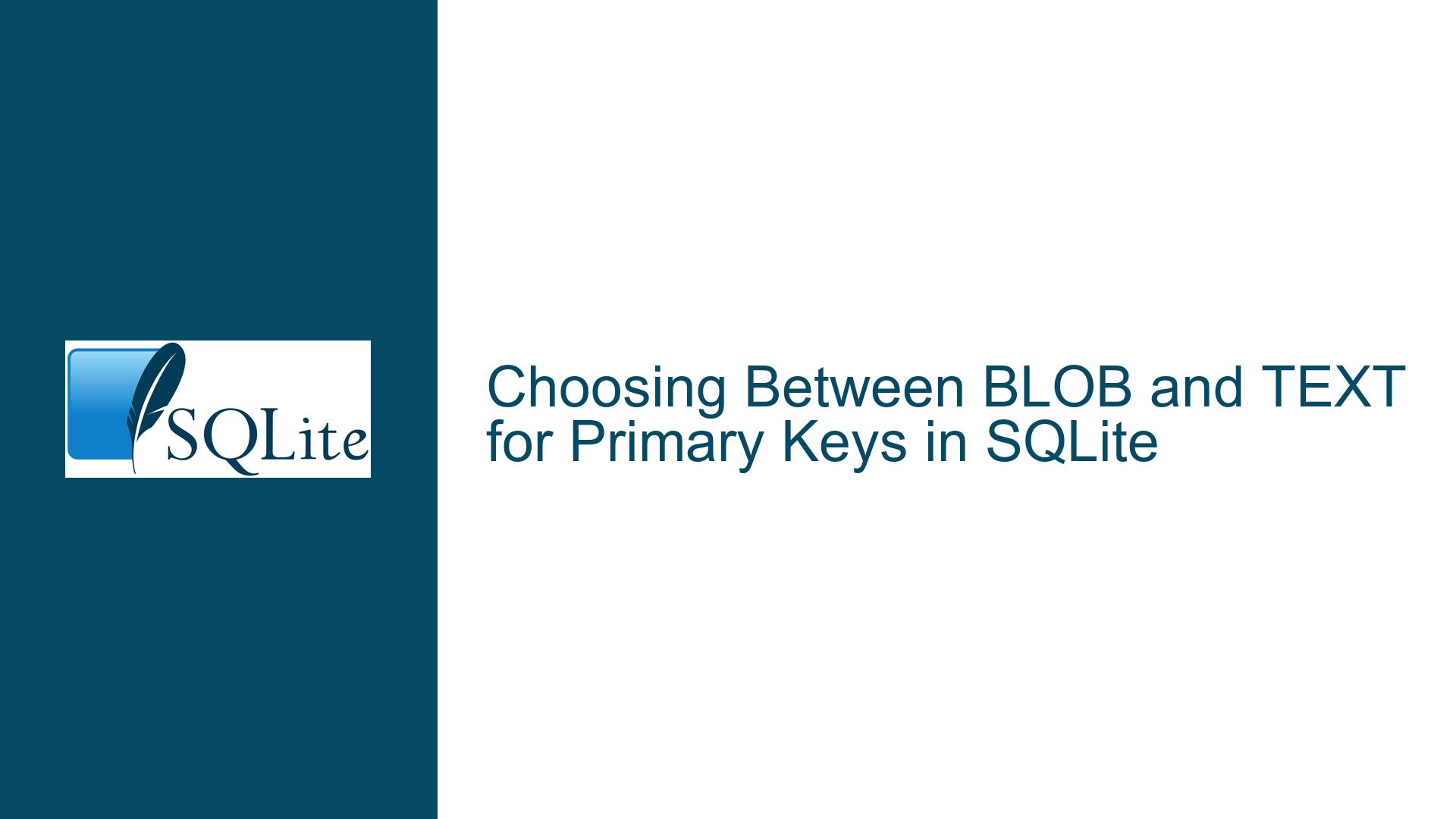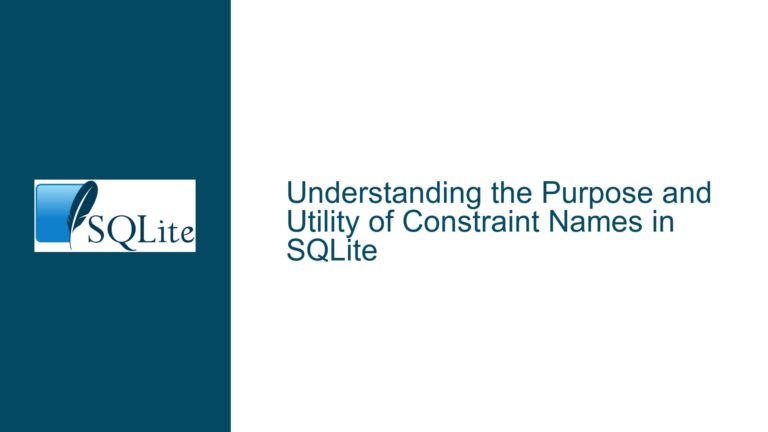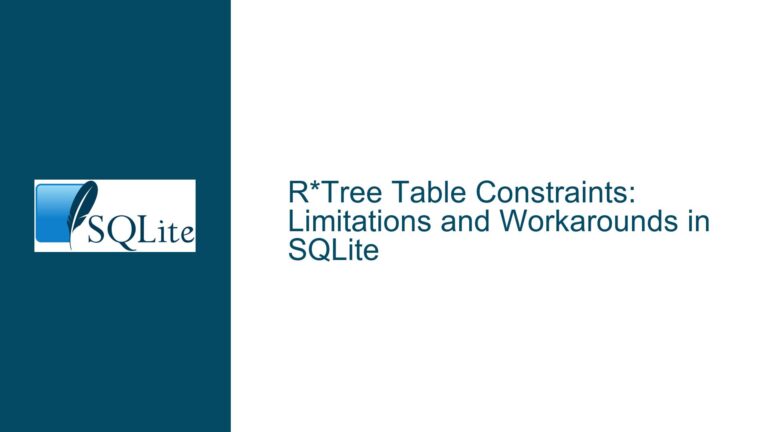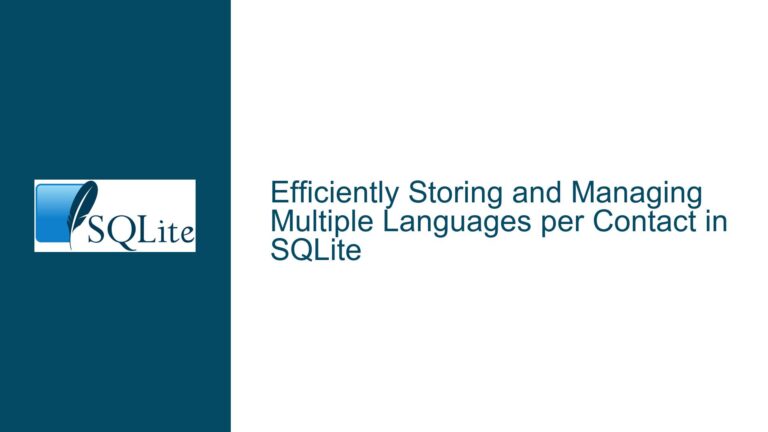Choosing Between BLOB and TEXT for Primary Keys in SQLite
Performance and Storage Implications of BLOB vs. TEXT Primary Keys
When designing a database schema in SQLite, one of the critical decisions is the choice of data types for primary keys. In scenarios where the primary key is a hash value, such as an SHA256 hash, the decision often boils down to using either a BLOB or a TEXT data type. Both options have their merits and drawbacks, particularly concerning performance, storage efficiency, and ease of use. This guide delves into the nuances of using BLOB and TEXT for primary keys, providing a comprehensive analysis to help you make an informed decision.
Storage Efficiency and Performance Considerations
The primary difference between using BLOB and TEXT for primary keys lies in how the data is stored and accessed. A BLOB (Binary Large Object) stores data in its raw binary form, while TEXT stores data as a string of characters. When dealing with hash values, such as SHA256, the choice between these two data types can have significant implications for both storage efficiency and query performance.
Storage Efficiency:
- BLOB: Storing a hash as a BLOB is more storage-efficient because it directly stores the binary representation of the hash. An SHA256 hash is 32 bytes long, and storing it as a BLOB will consume exactly 32 bytes per entry.
- TEXT: Storing a hash as TEXT typically involves converting the binary hash into a hexadecimal string. Each byte of the hash is represented by two hexadecimal characters, resulting in a 64-character string. This doubles the storage requirement to 64 bytes per entry.
Performance Considerations:
- BLOB: Since BLOBs store data in their raw binary form, operations involving BLOBs are generally faster. This is because there is no need for conversion between binary and text formats, and the smaller size reduces the amount of data that needs to be read from or written to disk.
- TEXT: While TEXT is easier to read and debug, it incurs additional overhead due to the conversion between binary and text formats. This can lead to slightly slower performance, especially in large datasets where the increased storage size can result in more disk I/O.
Indexing and Query Performance:
- BLOB: Indexing a BLOB primary key is straightforward and efficient. The binary nature of BLOBs allows for quick comparisons and lookups, which can be beneficial for query performance.
- TEXT: Indexing a TEXT primary key involves handling string comparisons, which can be slower than binary comparisons. However, the difference in performance is often negligible unless dealing with extremely large datasets.
Debugging and Developer Convenience
While performance and storage efficiency are critical factors, the ease of debugging and developer convenience should not be overlooked. The choice between BLOB and TEXT can significantly impact the development and maintenance of the database.
Debugging:
- BLOB: Debugging with BLOBs can be challenging because the raw binary data is not human-readable. Developers may need to convert BLOBs to a readable format (e.g., hexadecimal) to inspect the data, which can be time-consuming.
- TEXT: TEXT is inherently human-readable, making it easier to debug and inspect data directly. This can be particularly useful during development and troubleshooting.
Developer Convenience:
- BLOB: While BLOBs offer performance advantages, they require additional effort to handle in application code. Developers must ensure that the binary data is correctly serialized and deserialized, which can introduce complexity.
- TEXT: TEXT is easier to work with in application code, as it can be directly manipulated as strings. This can simplify development and reduce the likelihood of errors related to data handling.
Implementing BLOB and TEXT Primary Keys in SQLite
When implementing BLOB and TEXT primary keys in SQLite, it is essential to consider the specific requirements of your application. The following sections provide detailed guidance on how to implement each approach and the potential trade-offs involved.
Implementing BLOB Primary Keys:
To implement a BLOB primary key, you can define the primary key column as a BLOB type in your table schema. For example:
CREATE TABLE blob (
hash BLOB PRIMARY KEY,
content BLOB NOT NULL
);
In this schema, the hash column stores the raw binary SHA256 hash, and the content column stores the associated binary data. When inserting data, you must ensure that the hash is provided in its raw binary form.
Implementing TEXT Primary Keys:
To implement a TEXT primary key, you can define the primary key column as a TEXT type in your table schema. For example:
CREATE TABLE blob (
hash TEXT PRIMARY KEY,
content BLOB NOT NULL
);
In this schema, the hash column stores the hexadecimal representation of the SHA256 hash, and the content column stores the associated binary data. When inserting data, you must convert the binary hash to a hexadecimal string.
Comparison of Implementation Complexity:
- BLOB: Implementing BLOB primary keys requires careful handling of binary data. This includes ensuring that the hash is correctly serialized and deserialized when interacting with the database. Additionally, debugging and inspecting BLOB data can be more challenging.
- TEXT: Implementing TEXT primary keys is generally simpler, as the hash is stored as a human-readable string. This simplifies data handling and debugging but comes at the cost of increased storage requirements and potentially slower performance.
Best Practices for Choosing Between BLOB and TEXT Primary Keys
When deciding between BLOB and TEXT for primary keys, it is essential to weigh the trade-offs between performance, storage efficiency, and developer convenience. The following best practices can help guide your decision:
Prioritize Performance and Storage Efficiency:
- If your application requires high performance and efficient storage, consider using BLOB primary keys. This is particularly beneficial for large datasets where the reduced storage size and faster binary comparisons can lead to significant performance improvements.
Prioritize Developer Convenience and Debugging:
- If ease of development and debugging is a higher priority, consider using TEXT primary keys. The human-readable nature of TEXT can simplify development and troubleshooting, especially during the early stages of a project.
Consider Hybrid Approaches:
- In some cases, a hybrid approach may be appropriate. For example, you could store the hash as a BLOB for performance and storage efficiency while maintaining a separate TEXT column for debugging purposes. This allows you to benefit from the advantages of both data types.
Evaluate Specific Use Cases:
- The optimal choice may vary depending on the specific requirements of your application. For example, if your application involves frequent debugging or manual inspection of data, TEXT may be the better choice. Conversely, if your application is performance-critical and handles large volumes of data, BLOB may be more suitable.
Conclusion
Choosing between BLOB and TEXT for primary keys in SQLite involves careful consideration of performance, storage efficiency, and developer convenience. While BLOB offers advantages in terms of storage and performance, TEXT provides greater ease of use and debugging capabilities. By understanding the trade-offs and evaluating the specific requirements of your application, you can make an informed decision that best meets your needs. Whether you opt for BLOB, TEXT, or a hybrid approach, the key is to align your choice with the priorities and constraints of your project.






